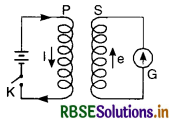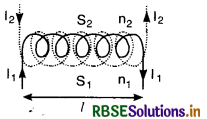RBSE Class 12 Physics Notes Chapter 6 Electromagnetic Induction
These comprehensive RBSE Class 12 Physics Notes Chapter 6 Electromagnetic Induction will give a brief overview of all the concepts.
Rajasthan Board RBSE Solutions for Class 12 Physics in Hindi Medium & English Medium are part of RBSE Solutions for Class 12. Students can also read RBSE Class 12 Physics Important Questions for exam preparation. Students can also go through RBSE Class 12 Physics Notes to understand and remember the concepts easily. Browsing through wave optics important questions that include all questions presented in the textbook.
RBSE Class 12 Physics Chapter 6 Notes Electromagnetic Induction
Electromagnetic Induction:
Electromagnetic induction is the process of production of current with the help of magnetic field by the method of induction.
Magnetic flux (Φ):
Magnetic flux (Φ) through any surface is the total number of magnetic lines passing through that surface.
If a surface has area A and magnetic field B is passing through the surface, then
Magnetic flux, Φ = B. A = BA cos θ
In SI, the unit of Φ is Wb.
Since Φ = BA
So 1 Wb = 1Tm2
Dimensional formula of (Φ)
Since Φ = BA cos θ
or [Φ] = \(\left[\frac{\mathrm{FA}}{q v}\right]=\left[\frac{\mathrm{FA}}{\mathrm{I} t v}\right]=\frac{\left[\mathrm{MLT}^{-2}\right]\left[\mathrm{L}^2\right]}{[\mathrm{A}][\mathrm{T}]\left[\mathrm{LT}^{-1}\right]}\)
[Φ] = [ML2T-2A-1]
Faraday’s laws of electromagnetic Induction
- First law. Whenever magnetic flux linked with a closed circuit changes, an induced e.m.f. (or current) is produced and it lasts so long as the change in magnetic flux continues.
- Second law. The magnitude of induced e.m.f. is directly proportional to the rate of change of magnetic flux linked with the circuit.
Mathematically,
e ∝ \(\frac{\phi_2-\phi_1}{t-0}\)
or e ∝ -k\(\left(\frac{\phi_2-\phi_1}{t}\right)\)
or e = -\(\frac{d \phi}{d t}\)
If the coil has N turns
e = -N\(\frac{d \phi}{d t}\)

Lenz’s law:
Lenz’s law states that the induced current produced in a circuit always flows in such a direction that it opposes the change that produces it.
Methods of producing induced e.m.f.
- By changing the magnetic field
- By changing the area
- By changing the orientation (θ) of the coil w.r.t the magnetic field.
Motional emf:
Motional emf is the induced emf produced by changing the area of a closed circuit by the movement of the circuit or part of it in a uniform magnetic field.
Motional e.m.f. e = B l v
And induced current
I = \(\frac{e}{\mathrm{R}}=\frac{\mathrm{B} l v}{\mathrm{R}}\)
Eddy currents:
Eddy currents are the induced currents produced in a conductor when magnetic flux linked with the conductor changes.
Magnitude of eddy current is
i = \(\frac{e}{\mathrm{R}}=\frac{d \phi / d t}{\mathrm{R}}\)
Eddy currents are used in
- Electromagnetic damping
- Induction furnace
- Magnetic brakes
- Electric power meters and
- Induction motor.
Self And Mutual Induction:
Self induction is the property of a coil by virtue of which, the coil opposes any change in the current flowing through it by inducing an e.m.f. in the coil.
Coefficient of self induction (or self inductance) of a coil is numerically equal to the amount of magnetic flux linked with the coil when unit current flows through it.
In a coil, the magnetic flux linked with it when current I is passing through it is given by
Φ ∝ I
or Φ = LI
[where L is called coefficient of self induction]
The induced e.m.f. produced in the coil due to self inductance is given by
e = -\(\frac{d \phi}{d t}=-\frac{d}{d t}(LI) = -L\frac{d I}{d t}\)
Units of self inductance:
The self inductance of coil is said to be 1H if a change of current equal to 1 ampere per second causes an induced e.m.f. equal to one volt in the circuit.
Self inductance of a solenoid:
Self inductance of a solenoid of radius r having n number of turns per unit length and a current I flowing through it has coefficient of self induction L given by
L = µ0n2lA

If the coil is wound on a material having relative permittivity fir, then
L = µ0µrn2lA
Mutual induction:
Mutual induction is the phenomenon of producing an induced current in a coil or circuit by changing current in a neighbouring circuit.

In a pair of coil as shown in the given figure, we find that the magnetic flux linked with S coil is proportional to the current I flowing in P coil. i.e. Φ ∝ I
or Φ = MF
[where M is called coeffcient of mutual induction]
The induced emf produced in S (secondary) coil is given by
e = -\(\frac{d \phi}{d t}=-\frac{d}{d t}(MI) = -\frac{\mathrm{M} d \mathrm{I}}{d t}\)
or M = -\(\frac{e}{d \mathrm{I} / d t}\)
Units of mutual inductance
Mutual inductance in a pair of coils is said to be 1 henry if a current changing at the rate of 1 As-1 in one coil induces an e.m.f. of IV in the neighbouring coil.

Mutual inductance of two long solenoids
Consider two long co-axial solenoids of length l having n1, I1 and n2, I2 be respective number of turns per unit length and current. Then the mutual inductance M is given by
M = µ0n1n2lA

Energy stored in an inductor:
Let L be coefficient of an inductor and current is changing at a rate \(\frac{dI}{dt}\) is passed through it, the induced emf produced in the inductor is given by
e = L\(\frac{dI}{dt}\) (in magnitude)
Work done by source, when I changes from 0 to I is given by
W = L \(\int_0^{\mathrm{I}}\) I dI = \(\frac{1}{2}\) LI2
This work done is stored in the form of energy
U = \(\frac{1}{2}\)LI2

- RBSE Class 12 Physics Notes Chapter 2 स्थिर वैद्युत विभव तथा धारिता
- RBSE Class 12 Physics Notes Chapter 3 विद्युत धारा
- RBSE Class 12 Physics Notes Chapter 4 गतिमान आवेश और चुंबकत्व
- RBSE Class 12 Physics Notes Chapter 5 चुंबकत्व एवं द्रव्य
- RBSE Class 12 Physics Notes Chapter 6 वैद्युत चुंबकीय प्रेरण
- RBSE Class 12 Physics Notes Chapter 7 प्रत्यावर्ती धारा
- RBSE Class 12 Physics Notes Chapter 8 वैद्युतचुंबकीय तरंगें
- RBSE Class 12 Physics Notes Chapter 9 किरण प्रकाशिकी एवं प्रकाशिक यंत्र
- RBSE Class 12 Physics Notes Chapter 10 तरंग-प्रकाशिकी
- RBSE Class 12 Physics Notes Chapter 11 विकिरण तथा द्रव्य की द्वैत प्रकृति
- RBSE Class 12 Physics Notes Chapter 12 परमाणु